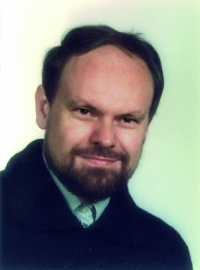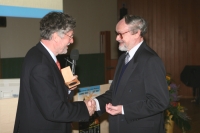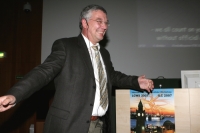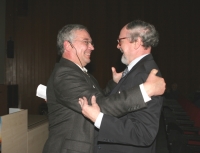 |
 |
|||||||||||||
|
|||||||||||||
|
|||||||||||||
|
In a packed auditorium many of world's leading high-energy physics brains celebrated ‘one of the sculptors of the physics of the ILC which wouldn’t be doable without him’, said Rolf-Dieter Heuer, DESY, and ‘not just a colleague, more of a friend’, said Siegfried Bethke, Max Planck Institute for Physics. Last Tuesday, a day before the start of the ILC / LCWS 07 symposium, they had gathered for a colloquium in honour of theorist Peter Zerwas, who is retiring at the age of 65, ‘after more than 250 publications, 12000 citations and certainly many more to come’, said Albrecht Wagner, DESY Director-General. So when a theoretical physicist is about to retire after many years of working on theories in particle physics at labs and universities, what does he look forward to doing in his retirement? Physics, of course. Peter Zerwas is leaving DESY after 16 years setting the pace for theories in particle physics, but a new office and desk are already waiting for him at Aachen university. “I will do it for pleasure, as I always have done” says Zerwas. “I don’t want to miss the results coming from the LHC next year — these are exciting times!”
By moving back to Aachen, Zerwas closes a circle that began at the university there in 1961. During his undergraduate years, Peter Zerwas was actually quite technical, doing research on the physics of nuclear reactors. When he got to know the theories behind elementary particle physics needed for understanding Fermi’s theory of reactors, he switched fields and became a theorist. “It was fascinating and it still is,” he says. He witnessed ground-breaking developments in physics, including the discovery of neutral currents at CERN, the unveiling of the quark structure of the proton at SLAC and the observation of gluon jets at DESY’s PETRA storage ring, which provided a basis for the theory of quantum chromodynamics or QCD. QCD was Zerwas’ main area of research for many years, starting from the analysis of gluon jets at PETRA, the hard fragmentation of heavy quarks, the hadronic structure function of the photon, and extending up to signals of the triple-gluon coupling that were later observed at LEP. He then switched to Higgs physics and supersymmetry studies both at the LHC and at linear colliders. He was part of the workshop held in Saariselkä in Finland that prepared the ground for the International Linear Collider ILC. He had just moved to Hamburg at the time, taking up his position in the DESY Theory group and at Hamburg University. In recent years, in close collaboration with ILC colleagues, he focussed on methods for reconstructing the physical scenario near the Planck scale hoping to find the ultimate unification of forces. Joe Lykken, a fellow theorist working at Fermilab in Chicago, has high respect for his work: “Peter Zerwas has led the theory community in the exploration of how measurements from the ILC and LHC could be used to shed light on the deepest questions of our science,” Lykken says. In his speech ‘QCD - The Strong Component of the Standard Model, MPI-Director Siegfried Bethke praised Zerwas’ sense for ’doable physics’ and the fact that he is a ’non-theoretic theorist.’ After many slides of personal memories and pictures from the past, he closed his speech with the words ’and now, Peter, you get a hug!’ -- Barbara Warmbein |
|||||||||||||
| © International Linear Collider |



